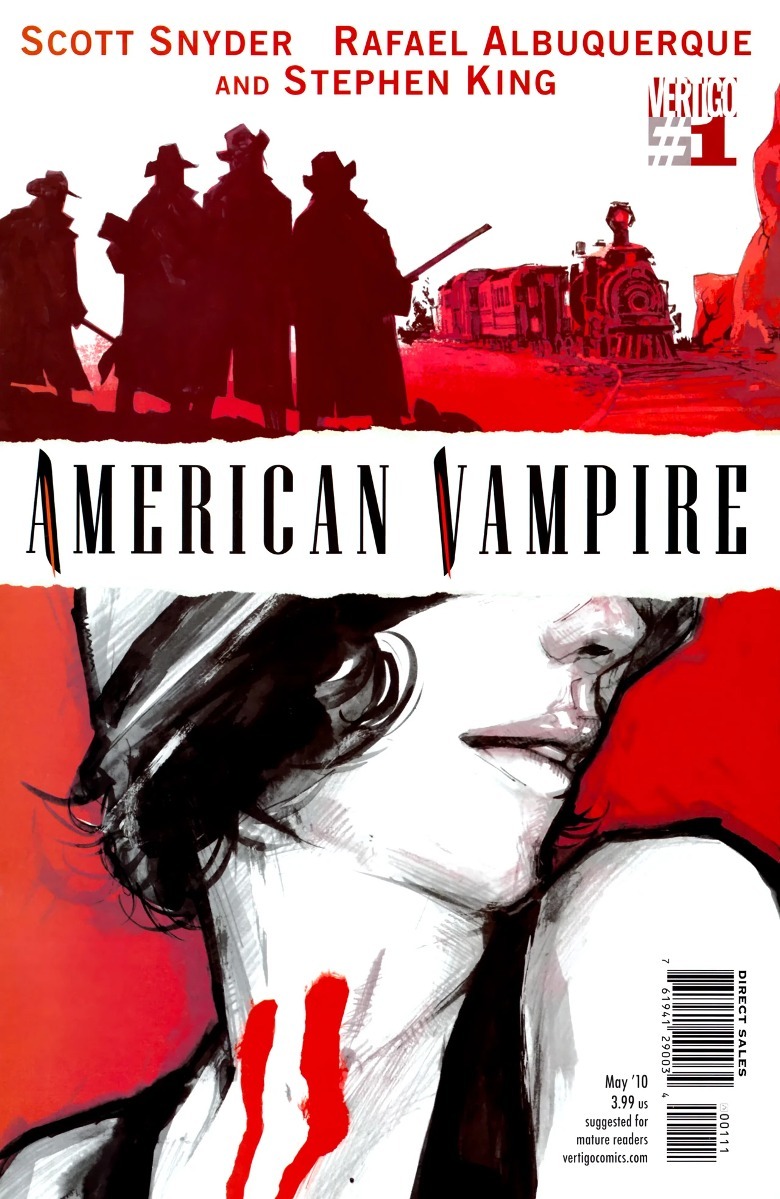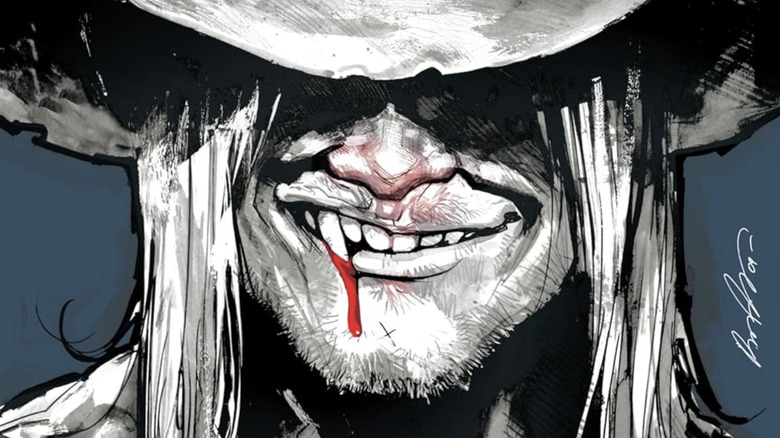Horror Maestro Stephen King Co-Wrote A Grisly DC Horror Comic
We may receive a commission on purchases made from links.
Most know Stephen King for his books, or movies based on those books. But he's dipped his toes into comics as well. During the 1980s, he contributed to Marvel Comics' "Heroes for Hope" one-shot and pitted the X-Men against a villain right out of his horror novels.
In 2010, King had a brief stint co-writing the horror comic "American Vampire" with series co-creator Scott Snyder. Published by DC's Vertigo imprint (the home of "Sandman," "Preacher," etc.), "American Vampire" was created by Snyder and artist Rafael Albuquerque. However, King's role was still important; he wrote the backstory of the comic's anti-hero lead.
The first volume of "American Vampire" (issues #1-5) is split between two stories. The first is set in 1920s Hollywood and written by Snyder. The second is a prequel set in the old West, written by King. Albuquerque's cover for "American Vampire" #1 shows this bifurcation. Above the title is a scene of outlaws about to rob a train. Beneath the titles, and the image that probably captures your eye, is a brunette flapper with blood slipping out of fang marks on her neck.
The connecting tissue of the two stories is the outlaw vampire Skinner Sweet, who continues to appear again and again even as "American Vampire" moves through time and follows new leads. An easy comparison is "American Vampire" and Anne Rice's "Vampire Chronicles" — both move through decades, following undying creatures of the night. Skinner is to Snyder's story what Lestat de Lioncourt is to Rice's. In temperament, Skinner is more like Severen (Bill Paxton), the black hat, leather-jacket-wearing vampire from "Near Dark."
Snyder had first conceived of Skinner Sweet before he even knew "American Vampire" would be a comic. Apparently, King was so entranced by Skinner too that he volunteered to write him.
How Stephen King became involved with American Vampire
Born in 1976, Scott Snyder is — like most horror writers of his generation — a Stephen King fan. He specifically credits King's book "Eyes of the Dragon" as having "jump-started [his] love of storytelling." Before breaking into comics, Snyder was a prose writer; in 2006, he published the short story collection "Voodoo Heart" for Dial Press. Printed on the back cover of "Voodoo Heart" is a glowing blurb from King, who proclaims the collection "blew [him] away."
In a 2010 interview with the Faster Times, Snyder explained he initially only reached out to King to get another blurb for "American Vampire." King liked his pitch, and Skinner, so much that he volunteered to write a few issues. Thus, Snyder got to directly work with the man who inspired him to write. (The following year, Snyder got another dream fulfilled when he was hired as the new writer of "Batman.")
King says he stuck strictly to Snyder's story outline, adding only "bells and whistles." (King in the "American Vampire" Volume 1 foreword: "Why f**k with genius?") In that foreword, King credits Snyder and editor Mark Doyle for easing him into the comic writing process; he also reviewed scripts from Brian Wood's "Northlanders" and reread his son Joe Hill's horror comic, "Locke and Key." Of Albuquerque's art, King wrote: "As a guy who can't even draw stick figures, I'm in awe."
King's "American Vampire" story is titled "Bad Blood." The story uses a framing device where, in 1925, pulp writer Will Bunting reveals that his novel about the vampiric Skinner Sweet (also called "Bad Blood") wasn't fantasy, but reality.
Stephen King wrote the origin of American Vampire
"Bad Blood" begins at the end of Skinner's outlaw career, when he's been captured by the Pinkerton agent (and his adoptive brother) Jim Book. Skinner's gang frees him, but they're killed by Bram Percy, the vampire banker who wanted Skinner captured in the first place. Skinner gets some of Percy's blood in his veins, and becomes the O.G. American vampire. While Book enjoys the life of a lawman, Skinner rests in his coffin eating rats. Until a flood washes away Skinner's prison and he sets out for revenge. He turns Jim into a vampire like himself, but Book resists the urges and dies of suicide by proxy via his lover Abilena.
King/Snyder's making Western robber barons into vampires is a storytelling choice as pointed as the end of a stake. (Snyder uses the same idea in his half of the story, where predatory Hollywood moguls are vampires.) The title "American Vampire" comes loaded with many meanings and one of them is the real vampires that run this country. It can also refer to both Skinner as an individual and the new breed of ghoul he represents. In this comic, vampirism is just another piece of culture brought from the old world to new and thrown into the melting pot. Like the descendants of immigrants, the American vampires aren't quite the same as those back in Europe.
The story ends back in 1925, where it turns out Skinner is one of the attendees at Bunting's book reading/confession. He leaves the writer an "autograph" as an aged Abilena and her/Jim's daughter Felicia spot him, planning revenge.
Later issues of "American Vampire" pick up with that open ending, but King's involvement ends there. The story is more Western than horror, but even that's not uncharted territory for King; his sprawling "Dark Tower" book series begins with "The Gunslinger," a simpler fantasy Western. Like "The Dark Tower" did, "American Vampire" grows in scope and mythos — and not always for the better. By the last mini-series, "American Vampire 1976," you can feel that Snyder's been writing too many superhero comics. Based on "Bad Blood," I was not expecting the climax of the series to be a kaiju-sized Skinner and Jim Book battling for the fate of humanity.
Hey, people don't usually come to Stephen King stories for a knock-out ending.
"American Vampire" can be read on digital reading service DC Universe Infinite Ultra. The first volume, part of DC's recent compact editions, can be purchased here.



